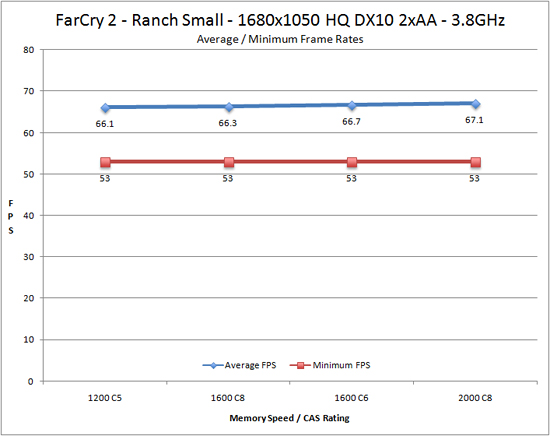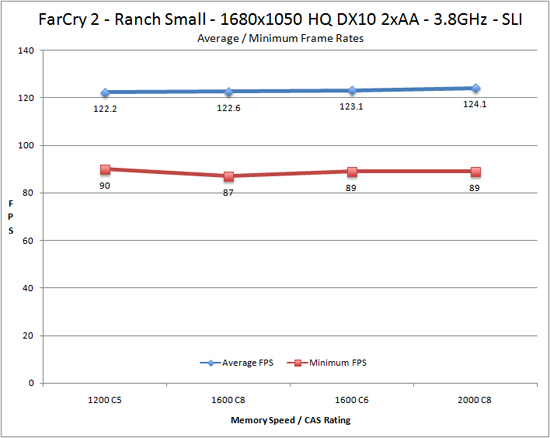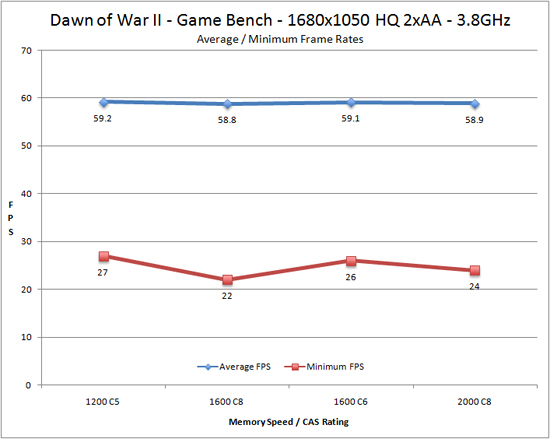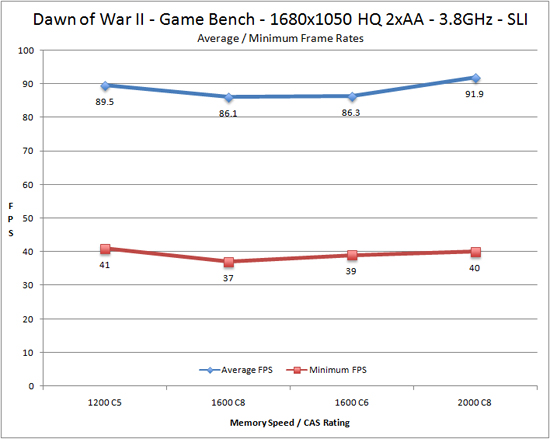Memory Scaling on Core i7 - Is DDR3-1066 Really the Best Choice?
by Gary Key on June 24, 2009 9:00 AM EST- Posted in
- Memory
Game Performance – Overclocked with SLI
Once again, we overclock our Core i7 920 to 3.8GHz (19x200) and run our standard game benchmarks at 1680x1050 2xAA HQ settings in single card and SLI configurations. This is a short synopsis of the results, but our other game benchmarks along with a 1920x1080 resolution performed in a similar manner. It appears in most of our games that minimum frame rates and sometimes average frame rates responded to the latency advantages inherent in 1200 C5 operation compared to the pure bandwidth advantage in 2000 C8.
FarCry 2
We set the performance feature set to Very High, graphics to High, and enable DX10 with AA set to 2x. The in-game benchmark tool is utilized with the Ranch Small level being selected for demo duties.


Average frame rates are up an astounding (had to make it interesting) 1% utilizing 1200 C5 over 2000 C8 while minimum frame rates improve by a ground shattering 0% when moving from 1200 C5 to 2000 C8 in single card results. In SLI operation, average frame rates improve by a familiar 1% as we crank up memory speed while minimum frame rates are 1% better when using 1200 C5 compared to 2000 C8. Obviously, the impact on actual game performance was nonexistent with any of our memory choices.
Warhammer 40K: Dawn of War II
We crank all options to High, enable AA, and then run the built-in performance benchmark for our result.


In our stock tests, this game responded very well to memory changes as average frame rate performance increased by 3% and minimum frame rates by 41% when moving from 1066 C7 to 1600 C6. However, in single card mode we see a minimal impact on average frame rates while minimum frame rates improve by 12% using 1200 C5 compared to 2000 C8. In SLI mode, average frame rates increased almost 3% moving from 1200 C5 to 2000 C8 but minimum frame rates improved a little over 2% with 1200 C5 having the advantage over 2000 C8.
World in Conflict - Soviet Assault
We set our options to High, DX10, 2xAA. 4xAF, and then utilize FRAPS to track a repeatable game sequence for our results.


Our single card results have the average frame rates flat lining but we do see a drop in minimum frame rates with DDR3-1600 C8. In the SLI test, average frame rates improve by 2% and minimum frame rates by 5% when moving from 1200 C5 to 1600 C6.










47 Comments
View All Comments
sonci - Thursday, June 25, 2009 - link
The title was enough,and yours is too..
goinginstyle - Wednesday, June 24, 2009 - link
I have no idea where you have been hiding Gary but it is great to see you back. I look forward to the AMD article and the individual module tests. If they are half as good as this, I will be one happy person. Any chance or comments on Virtualization benches under WIn7 with XP?duploxxx - Wednesday, June 24, 2009 - link
very nice article with real world applications, now can you pls do the same with amount of dimms used and finally kill this marketing hype?vailr - Wednesday, June 24, 2009 - link
Re:"Current JDEC specifications list 1.50V as the official voltage specification for DDR3 with a move to 1.35V in the near future and eventually to 1.20V."
How does DDR5 (already being used on some video cards) voltages compare with those numbers?
Any predictions on when DDR5 memory modules for main boards might be introduced?
Are lower latency DDR3 modules "in the works"?
Maybe such a thing as:
1333 MHz @4-4-4-12 & 1.20v, for example?
Also: Intel promotes the benefits of using Hafnium when producing their CPU's. Would Hafnium also benefit memory chips?
GourdFreeMan - Thursday, June 25, 2009 - link
The video cards you are thinking of use GDDR, not DDR. You will never find GDDR packaged on DIMMs for motherboard memory slots, but rather only as individual chips for graphics boards and consoles. Though they share some technologies, you would need a different memory controller to make use of it. Typically GDDR5 runs from 1V to 1.4V (the GDDR5 on the stock Radeon HD 4770 runs at 1.263V for example). Hafnium dioxide has already been used by some manufacturers as the dielectric material in DRAM capacitors, and I know NEC, at least, has already used Hafnium in transistor gates for embedded DRAM. As for higher speed and lower latency RAM, that is pretty much always in the works...Zorlac - Wednesday, June 24, 2009 - link
I have thought this all along, but was too lazy to prove it. Thanks Anand!!! :)Any idea when we will start seeing 4GB DIMMs for running 3x4GB kits?
Gary Key - Wednesday, June 24, 2009 - link
We just finished testing a 12GB 1600 C9 kit from Kingston, but the street price is $1400. I also have a 24GB kit from Corsair, but I will not even mention the cost on that one. We should see affordable (compared to buying 6x2GB) 12GB kits later this year in the 1333 C8 variety without ECC. I do have a 12GB ECC Kingston 1066 C8 kit arriving shortly, retail is about $320, to test in some workstation products.DXRick - Wednesday, June 24, 2009 - link
It looks like the sweet spot is 1600 C8 at around $100 for a 6BG kit.vol7ron - Wednesday, June 24, 2009 - link
agreed --- those saying 1333 really are saving the buckI would still like to see SuperPi tests, since they are a mathematical approach to memory performance.
Gary Key - Wednesday, June 24, 2009 - link
Super Pi results will come in Raja's 2000 shootout. However, most of the Super Pi program runs in cache and when it goes outside of it,it only hits a couple of ranks in short bursts (why bandwidth matters) and as a result a proper loading of the entire memory subsystem is not really tested thoroughly. That said, we will have a complete subsection on Super Pi for the overclocking crowd. :)